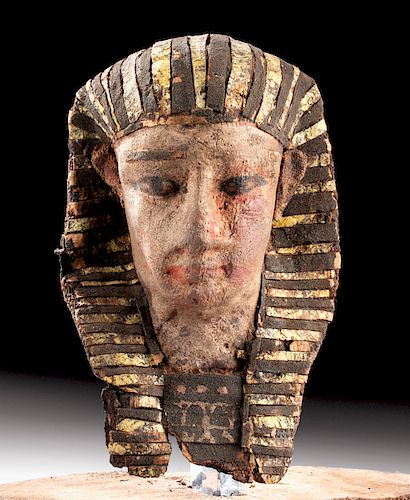Rare Egyptian Ptolemaic Painted Linen Corn Mummy Head
Lot 14c
About Seller
Artemis Fine Arts
686 S Taylor Ave, Ste 106
Louisville, CO 80027
United States
Selling antiquities, ancient and ethnographic art online since 1993, Artemis Gallery specializes in Classical Antiquities (Egyptian, Greek, Roman, Near Eastern), Asian, Pre-Columbian, African / Tribal / Oceanographic art. Our extensive inventory includes pottery, stone, metal, wood, glass and textil...Read more
Estimate:
$4,000 - $6,000
Absentee vs Live bid
Two ways to bid:
- Leave a max absentee bid and the platform will bid on your behalf up to your maximum bid during the live auction.
- Bid live during the auction and your bids will be submitted real-time to the auctioneer.
Bid Increments
| Price | Bid Increment |
|---|---|
| $0 | $25 |
| $300 | $50 |
| $1,000 | $100 |
| $2,000 | $250 |
| $5,000 | $500 |
| $10,000 | $1,000 |
| $20,000 | $2,500 |
| $50,000 | $5,000 |
| $100,000 | $10,000 |
| $200,000 | $20,000 |
About Auction
By Artemis Fine Arts
Sep 26, 2019
Set Reminder
2019-09-26 10:00:00
2019-09-26 10:00:00
America/New_York
Bidsquare
Bidsquare : Exceptional Day 1: Antiquities & Asian Art
https://www.bidsquare.com/auctions/artemis-gallery/exceptional-day-1-antiquities-asian-art-4437
Day 1 of an important 2-day auction featuring exceptional, museum-worthy examples of Egyptian, Greek, Etruscan, Roman, Viking, Russian, Near Eastern, as well as Asian Art from China, Japan, Thailand, Vietnam, Burma and India. Artemis Fine Arts info@artemisgallery.com
Day 1 of an important 2-day auction featuring exceptional, museum-worthy examples of Egyptian, Greek, Etruscan, Roman, Viking, Russian, Near Eastern, as well as Asian Art from China, Japan, Thailand, Vietnam, Burma and India. Artemis Fine Arts info@artemisgallery.com
- Lot Description
Egypt, Ptolemaic to early Romano-Egyptian period, ca. 332 BCE to 1st century CE. A rare head from a corn mummy, the face formed by placing layers of woven linen inside a face-shaped mold and solidifying them with light plaster or bitumen. The face is decorated with red lips, black eyes, applied fibrous eyebrows, and petite ears, with a striped yellow-and-black Nemes headcloth bearing lengthy frontal flaps, and a central panel atop the chest depicting three ambiguous items, perhaps slender lotus flowers or thin hes-vases. The white-painted face indicates the effigy is depicting not an individual of Egyptian descent, but of Greek descent consistent with the Ptolemaic period. The back of the head is reinforced with jet-black bitumen, and the hollow interior would have fit over the neck or head area of a full corn mummy body. Corn mummies are ritual objects buried in place of a deceased individual inside a box surmounted by an effigy of the funerary deity Ptah-Sokar Osiris. Size: 3.625" W x 5.625" H (9.2 cm x 14.3 cm); 7.4" H (18.8 cm) on included custom stand.
Provenance: private J.H. collection, Beaverton, Oregon, USA
All items legal to buy/sell under U.S. Statute covering cultural patrimony Code 2600, CHAPTER 14, and are guaranteed to be as described or your money back.
A Certificate of Authenticity will accompany all winning bids.
We ship worldwide and handle all shipping in-house for your convenience.
#149829Losses to areas of eye brows, areas of Nemes headcloth, frontal panel on chest, peripheries, and verso as shown. Fading to areas of original pigmentation, desiccation commensurate with age, nicks and abrasions to face, headcloth, peripheries, and verso, and traces of bitumen on verso. Great remnants of original pigment throughout.Condition
- Shipping Info
-
All shipping is handled in-house for your convenience. Your invoice from Artemis Gallery will include shipping calculation instructions. If in doubt, please inquire BEFORE bidding for estimated shipping costs for individual items.
-
- Buyer's Premium



 EUR
EUR CAD
CAD AUD
AUD GBP
GBP MXN
MXN HKD
HKD CNY
CNY MYR
MYR SEK
SEK SGD
SGD CHF
CHF THB
THB














